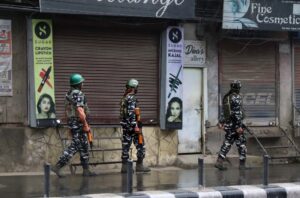Soldiers walking down the street in Srinagar, Kashmir (photo: Katarzyna Rybarczyk)
by Katarzyna Rybarczyk 21 September 2022
An ethnically diverse Himalayan region of Kashmir has been a subject of a territorial dispute between India and Pakistan since the partition in 1947. Despite both countries claiming full control over the region’s entirety, Kashmir is divided between them, into an Indian-administered part and a Pakistan-administered part.
For the last three decades, Indian-controlled Kashmir has been characterised by unrest due to a separatist insurgency opposing the Indian rule. Although India’s fragile relationship with Kashmir is not a new issue, tensions intensified when in 2019 India revoked Article 370, depriving the region of its special status and a certain degree of autonomy attributed to it.
Article 370 allowed Kashmir to have its own constitution and to make decisions regarding property ownership and permanent residency. As a result, Indians from other parts of the country were not able to purchase property and settle in Kashmir.
Scrapping Kashmir’s special status meant that from that point onwards, the state would have to abide by the Indian constitution.
Fearing state-wise unrest after announcing the decision, the Indian government increased the number of troops in the region and has since then been maintaining a massive army presence in Kashmir.
But is the high army presence in Kashmir a measure necessary to maintain stability or is it indicative of the Indian government violating people’s rights to demand absolute obedience?
Restricted freedoms
Revoking Kashmir’s special status in 2019 was followed not only by Indian troops pouring into the streets but also by a communications blackout which only ended in 2021, and by restricting the media.
These measures, adopted by India in anticipation of rather than in response to unrest in Kashmir, represented a serious violation of people’s freedom of expression. And, although internet connectivity has been restored now, the curtailment of people’s fundamental liberties continues.
‘We are not allowed to protest in the streets. Protests can only happen in this one square,’ Zahid, a participant of one of the recent protests, told me. This particular demonstration was about Finance Account Assistants (FAA) opposing the authorities’ decision to scrap the merit list, thus halting the selection process.
But even in this one designated spot demonstrations tend to be small, partially due to the fact that people are afraid of the military using force should a larger protest take place, and partially because, after years of having their voices suppressed, they have lost faith in being able to change the oppressive status quo.
Another way in which the security forces have been curbing people’s freedom are cases of unjustified violence.
‘Just the other day I was beaten up because I asked why they had stopped the traffic and wouldn’t let us pass. Another incident occurred two days earlier, where few drivers were beaten up. No action has been taken,’ Viraj, a doctor who lives in Srinagar, said.
Psychological effects of weapons
India-administered Kashmir is one of the world’s most militarised areas. At any given moment there are tens of soldiers patrolling the streets of Srinagar, Kashmir’s summer capital, and checkpoints can be seen at every corner.
‘This is the reality of life in a conflict zone. Often people from outside the region see Kashmir as a tourist paradise but those who live here feel a sheer amount of pressure. Just seeing weapons has psychological effects on regular people,’ Viraj explained and added that ‘rebellions are bound to occur when you pressure people into obedience.’
Still, by making sure that people know they are constantly being watched by the military which is capable of using excessive force, India has ingrained a sense of vigilance in people’s minds. Nowadays, there are significantly less revolts and massive strikes involving stone pelting have become a thing of the past.
What cannot be overlooked, however, is the fact that heavy military deployment has had a fair share of tangible success in enhancing the security of the region. The number of terrorist incidents decreased from 417 in 2018 to 229 in 2021, according to Amit Shah, the Minister of Home Affairs. And, for some Kashmiris, increased army presence has improved their sense of safety.
‘The presence of Indian forces is essential to protect the people of Kashmir, especially those who are not radicalised and do not support the insurgency against the government,’ Kamal, Kashmir’s resident, said.
Never-ending conflict?
At the moment, Kashmir is experiencing a period of relative stability and peace but security challenges persist so there is a risk that this order will be short-lived.
‘There has been a security threat in Kashmir since 1990. The government has been changing since then but the army presence has been a constant,’ Kamal explained.
Here lies the inherent paradox of the situation in Kashmir. The longer India’s military rule continues, the more people will be turning against the Indian government and joining the ranks of militant groups. At the same time, this leads to increased security threats and the Indian government having no choice but to retain its troops in the region to keep the situation under control.
And, removing the army, which is seemingly what many Kashmiris want, could potentially trigger chaos and uproar.
‘There would certainly be more unrest if the army was removed without any improvements in administering the region,’ Kamal told me. So, before the possibility of one day withdrawing Indian troops from Kashmir can even be considered, fundamental reforms to how the troubled territory is governed are necessary.
When the Indian government took back Jammu and Kashmir’s limited autonomy, it announced that the conflict there was resolved and that the region’s integration with the rest of the country was officially complete. In reality, however, the resolution of the tensions between the Indian government and the people of Kashmir remains a distant dream.

